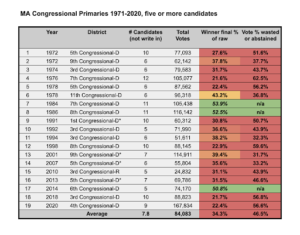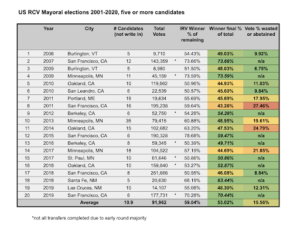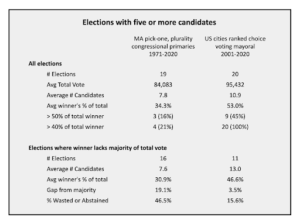By Nathan Lockwood
American voters have a problem—as soon as we get the benefit of more than two choices in an important election, we waste our ballots and elect someone who most people didn’t vote for. This is the excitement and disappointment of “the crowded field.” It is a process that is currently “out of control.”
Representatives are getting elected to office with very low numbers of support—sometimes earning less than 25% of the vote, as happened famously in my state of Massachusetts in Congressional District 4 in 2020 and in Congressional District 3 in 2018. While those are just two examples from one state; it’s actually happening all over the country. This is reflected in this recent research by Kevin Johnson of Electoral Reformers Network: “Less than half the members of the 115th House (213 out of 435) won their first primary with a majority. 80 representatives had 35% support in the primary or less.”
But we are in luck! There is “one simple change” to our elections called ranked choice voting (RCV) that can help make sure every vote counts and that the leaders elected to represent us are preferred by the broadest possible majority of voters relative to the other competing candidates.
How real is the problem and what is the proof that ranked choice voting can fix it? As an example, one direct and appropriate comparison is to look at the last fifty years of the Massachusetts’ pick-one, plurality Congressional primaries and view them against all of the ranked choice voting mayoral elections in the past twenty years in the United States. To understand how both election formats perform for election quality, measured by strength of support of winners as choice increases, we’ll focus on elections with five or more non-write-in candidates—this gives us a set of nineteen Massachusetts congressional and twenty RCV mayoral elections.
So what does the comparison tell us?
On the surface these two sets of elections have a lot in common. The nineteen Massachusetts pick-one elections had an average of 84,000 valid votes cast for eight candidates and the twenty RCV elections 95,000 for eleven candidates. Both sets of elections featured a lot of voters choosing from a lot of candidates.
That’s pretty much where the similarity ends. Of the nineteen pick-one elections, only three were won by a candidate who earned a majority—a mere 16% of pick-one elections had majority winners. Of the twenty RCV elections, nine of them (45%) were won with a majority of the total valid votes cast (all of them had majority winners in the instant runoff). RCV elections were three-times more likely to have a majority winner than Massachusetts pick-one elections.
Ok, but maybe the pick-one elections were won with “strong pluralities,” defined as 40% or more? For the pick-one elections that were not won with a majority, the average percent of the vote earned by the winner was a mere 31%. Not only did they not get half the vote, the average pick-one winner of these elections did not even get one-third of the vote. By contrast, in the RCV elections with no majority of the overall vote count, the winners still averaged 47% with the worst performance being 43% (in an election with a field of sixteen). Ultimately, every RCV election was won with at least a strong plurality of the total vote. If we look at the winners’ totals as a “gap” from a majority win, the gap for these pick-one elections is almost six times larger than for the RCV ones.
The Difference Between a Vote That ‘Counts’ and a Vote That is ‘Wasted’
Now let’s look at the elections from the standpoint of making sure votes count and are not wasted. What does this mean exactly? To “count,” it means that your vote had a meaningful impact on the result, defined by counting towards one of the top-two competing candidates. Otherwise, your vote is “wasted;” it would have had an impact on the final outcome only if you had cast it for a different candidate.
You might say your vote was not wasted if you would not have voted for either of the top two candidates even if your pick was not running. In that case, we might say you “abstained” from voting for the top two. If any candidate wins with the majority of the raw vote, we’ll consider that no votes were “wasted” or “abstained,” as the outcome would not have changed regardless of how those who favored the other candidates voted.
For the elections where no candidate received more than half the votes, a staggering 47% of pick-one ballots were wasted or abstained, compared with 16% of RCV ballots. In elections not won by a majority, nearly half of voters in the Massachusetts pick-one elections saw their votes wasted or abstained and this was three times more than in the similar RCV elections.
Winners and voter choice in ranked choice voting elections
So you might say, “I thought RCV can guarantee the election is always won by a candidate with majority support and that no votes are wasted?” These statements are true but context is important.
In an RCV election using “instant runoff” counting, the winner will always have majority support relative to the next strongest candidate, with as many ballots as possible consolidated into that count through instant runoff elimination rounds. However, because voters are not forced to support any particular candidate—they can rank as many or as few as they like and “abstain” from the rest—the winning majority between the top two candidates in the runoff may not always be a majority of all ballots cast.
Compared with pick-one voting, under RCV this “abstention” is much more likely to represent a deliberate choice by the voter to not support either candidate that ended up as the top two. On a ranked ballot, there is nothing that prevents a voter from ranking additional candidates that they wish to, and when they do so, it will not harm their top choice.
In pick-one elections, voters do not even have the option to have a “backup choice” for insurance in case their top choice falters. Voters in pick-one elections are forced to abstain from all of the candidates, except the one they choose to vote for—which because of strategic voting pressures, isn’t even always their favorite —whether they want to or not.
In an election with five or more contenders, while it is possible to identify front-runners and likely top performers from polling and fundraising numbers, it is not possible to identify who the top two are with certainty, as there are often as many as four to six strong candidates.
If your favorite candidate is not a front-runner, your dilemma is even worse. On pick-one ballots, the chance of wasting your vote is high and, unlike with ranked ballots, there is little you can do about it. If there are four roughly equally strong, front-running candidates, two will not make the top two. Even if you are trying to vote for one of the top two, on a pick-one ballot, there is a two out of four or 50% chance you will waste your vote. With five strong candidates, that goes up to 60%. With ranked ballots, you have the option to rank as many of these front-runners (or other candidates) as you care to. Ranked choice voting protects you so that your vote is not wasted unless you choose to abstain from ranking some candidates, and the candidates you did not rank happen to include both of the top two.
Seventy percent (fourteen of twenty) of the RCV contests in this comparison took place in cities that were modern American “early adopters” of RCV where the election equipment presented constraints, and voters were limited to ranking only up to three candidates. So in these elections with large fields and limited rankings, while much better than pick-one, there was likely significant “forced abstention” where the constraints of the ballot prevented some voters from ranking all of the candidates they may have wished to. It’s worth noting that many of these cities have or are in the process of upgrading their voting machines to handle ballots that support more choices, and most jurisdictions now adopting RCV implement without this constraint.
We all win with ranked choice voting
For electing winners with the broadest possible support, ensuring the maximum votes count, and the fewest are wasted, the ranked choice voting elections have massively outperformed the Massachusetts pick-one elections. 100% of the RCV elections had a majority or strong plurality winner based on the total vote count, against only about 20% of the pick-one elections. The average RCV winner earned 53% support of all votes versus 34% for the pick-one elections.
RCV elections were almost three times more likely to be won with a majority of the total vote count, and in elections with no raw majority winner, the RCV elections had almost three times fewer wasted or abstained votes. This outperformance occurs despite greater candidate participation and more voter choice—in the form of bigger field sizes in the RCV elections—on average forty percent more candidates than the corresponding pick-one elections, and also despite the ballot constraints in most of the RCV elections included (discussed above).
The historical evidence is clear: When contests for critically important offices get competitive with multiple options for voters to choose from, our pick-one elections get broken. In the last two decades, ranked choice voting has built up a track record, been stress-tested, and passed with flying colors. Ranked choice voting now stands out as an obvious and easy solution to wasted votes and election results that fail to guarantee accurate representation. It’s time for American voters to be able to celebrate the freedom of choice presented by crowded fields, while retaining real control over the outcomes. To make every ballot cast count as much as each voter wishes and ensure that our elected leaders are chosen based on the support of the broadest majority, we need ranked choice voting.
If you like the idea of ranked choice voting, you can help get it on ballots across the country by joining us or by donating.
Nathan Lockwood is Executive Director of Rank the Vote. He played a leading role in founding and growing Voter Choice Massachusetts both as the regional lead for Central Massachusetts and through various statewide roles. He also served on the board of directors of the Voter Choice Education Fund.
Nathan was elected to the Town of Lunenburg, Massachusetts Planning Board and served from 2009 through 2015. His career in the software industry spanned 25 years and included engineering, design, and management roles. He holds a BA in Philosophy from Yale University.
The views and opinions expressed in this article are those of the authors and do not necessarily reflect the official policy or position of Rank the Vote, its members, supporters, funders, or affiliates.




